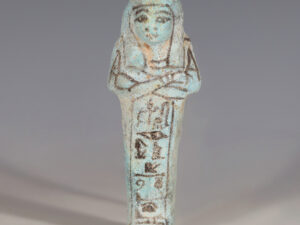Shabtis, or ushebtis from the Third Intermediate Period, are small figurines buried with the deceased, intended to carry out menial labour on their owner’s behalf in the afterlife. To reflect this function, they are usually depicted in the form of a mummy holding tools in their hands – baskets, mattocks and hoes. Shabtis are among the most numerous of Egyptian antiquities, as they played a major role in funeral rites. During the Third Intermediate Period, it was typical for burials to contain hundreds of shabtis.The Egyptians worked to a 10-day week, with 5 days as holiday. A year consisted of 360 days. To accommodate this work schedule in the afterlife, burials contained close to 400 shabtis; 365 workers and 36 overseers.
The quality of ushebtis in this period declines. Whilst many shabtis were inscribed with the title and name of the owner, or chapter 6 of the Book of the Dead, towards the end of the Third Intermediate Period, this declines. It was common to include plain figurines, made simply and poorly.
To discover more about Egyptian shabtis, please visit our relevant blog post: How Ancient Egyptian Shabtis and Funerary Statuettes Watched Over the Dead.





















